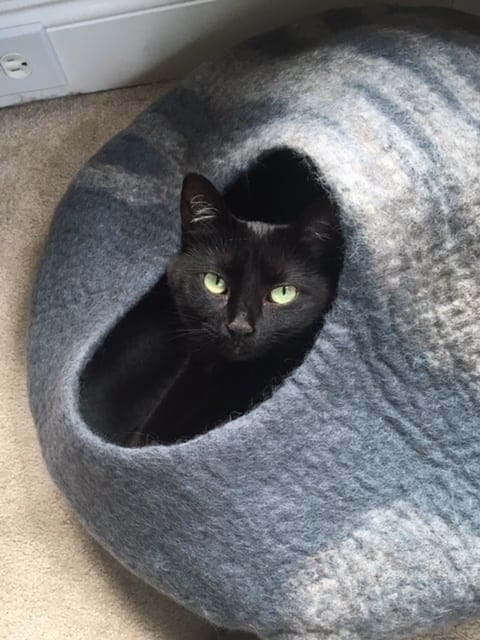
Listen to the audio version of this article
Whether it’s a new boyfriend, girlfriend or a new spouse, life in that rose-covered cottage can quickly turn into Nightmare on Elm Street if the cat appears to hate the love of your life. Beginning a new relationship is stressful enough without the cat coming into the room to hiss or growl. There are some people who will simply throw their hands up in the air and rehome the cat in order to please the new loved one. Then there are others who seriously consider ditching the new boyfriend or girlfriend based on the cat’s negative feedback. There’s a much better option than either one of the two mentioned above. Here are a few tips to get you started on the road toward having your cat see the good side of Mr. or Ms. Right.
Your Cat Isn’t Jealous
This may come as a shock to you but your cat isn’t reacting this way because she’s upset at the fact that you’re spending more time with someone else. It’s actually confusion and fear that have her being less than hospitable to your spouse. Your cat is a territorial creature of habit and it can be very unsettling and stressful for her to suddenly have someone unfamiliar spending time in the house. In the case of a new boyfriend or girlfriend, people often make the mistake of trying too hard to get kitty to like the new person. The cat parent almost forces the two together. The cat parent may pick up the cat and physically place her in the new person’s arms. The cat hasn’t had any time to do a scent investigation or figure out if this person is friend or foe. Add to that, the fact that this person is probably spending time in more areas of the house that the cat considers more of her personal territory. For example, if the cat is used to sleeping in bed with you and then suddenly she’s banished from the bedroom, it can be very unsettling and confusing.
In the case of a new spouse or if the new boyfriend or girlfriend moves in, that becomes an overwhelming invasion into the cat’s territory. All of a sudden there’s furniture, clothes and other belongings that have an unfamiliar scent being hauled into the house. If you’re moving to your new spouse’s house or moving into a new house together, it can be even more overwhelming because now your cat has also lost all of her familiar territory.
Changing Your Cat’s Mind About Your Spouse
First of all, you can’t rush this process. Cats need to feel as if they have a choice. The more you try to force the cat on your spouse, the more the cat will back away. You have to go at the cat’s pace. What matters to kitty is that the new person in the home isn’t a threat so if you rush the process, it’ll just intensify your cat’s anxiety.
Sock Magic
Let’s start with scent. You can help your cat begin to feel more comfortable if your spouse carries some of kitty’s scent. Take a clean sock and gently rub around your cat’s mouth to collect some of her facial pheromones. Cats have scent glands on their body and the ones around the mouth contain the pheromones (scent chemicals) that are the “friendly” ones. Cats facially rub on objects when they feel comfortable in the environment. Take that sock and rub some of your spouse’s personal belongings such as shoes, briefcases, purses, etc. Get more socks and repeat the process (not all at one time – don’t wear your cat’s cheeks out). You can also rub the pheromone-baited sock on the corners of furniture pieces belonging to your spouse.
You can also have your spouse wear pheromone-baited socks around the house.
The Way to a Cat’s Heart is Through Her Stomach
Have your spouse be the one who prepares the cat’s food and serves it. Your cat may not feel comfortable eating with your spouse in the room but the scent of your spouse on the food bowl will be a start toward her associating good things with the presence of this new person.
Treat-giving can also be done by the spouse. It may initially involve casually tossing a treat so the cat can eat it from a distance. You can also do clicker training with your cat so that you can click and reward for any positive step toward your spouse. In some cases, that positive step may simply be that the cat is willing to step into the room where your spouse is sitting. Regardless of whether you clicker train or are simply offering treats for desired behaviors, set the bar low enough so the cat is rewarded for the smallest of steps.
The Power of Play
Playtime is a powerful tool in your behavior modification toolbox. When a cat is in play-mode, she’s having a good time, the good brain chemicals are being released and she’s making positive associations with her surroundings. Initially, you may have to conduct the play sessions while your spouse sits on the sidelines, but it’ll be a way for your cat to see that she can relax her guard and focus on the toy instead of worrying about your spouse. Use an interactive toy based on a fishing pole-design so you can keep the action going. Don’t move the toy too close to your spouse. Keep the action within the cat’s comfort zone.
In subsequent sessions, you can sit closer to your spouse as you conduct the interactive play session and then eventually hand the toy off to the other person. Work up to having your spouse initiate the games with your cat.
The Environment
Provide your cat with plenty of areas where she can retreat and feel comfortable when your new spouse is around. If there’s no place for her to hide or retreat, she’ll feel very vulnerable and end up diving under the bed. There should be at least one cat tree in the environment so your cat can have a high elevation where she can feel safe. Instruct your spouse that the cat tree is off-limits and when the cat is up there it means she wants to be left alone. If your spouse respects that then the cat will begin to feel as if she can go to the tree instead of hiding under the bed in another room.
Create hideaways using “A” frame cat beds, boxes on their sides, donut beds etc., so your cat can feel invisible yet be able to stay in the room. Being able to hide is an important coping mechanism and can provide much needed security.

Photo: Pam Johnson-Bennett
The Litter Box
If the litter box is currently located in an area where your spouse will also be (such as the bedroom or master bathroom), set up an additional box in another area so your cat will always have a choice. This may also be the perfect time to increase the number of boxes so you can place them in multiple locations. That way, your cat doesn’t have to pass your spouse in order to take care of personal business.
Making Contact
If your cat approaches your spouse, let her do a scent investigation without being interrupted. Just because she comes up to sniff your spouse’s pant leg doesn’t mean she wants anyone reaching down to pet her or pick her up. Even if the cat walks across your spouse’s lap, let her do so undisturbed. It’s better to leave your cat wanting more rather than rushing the process and ending up with her darting away again. Instruct your spouse not to stare directly at the cat because in the animal world, a direct stare can be viewed as a challenge or threat. Instead, if any eye contact should be brief and soft. Show your spouse how to use polite cat etiquette by extending an index finger and letting the cat sniff it. This is similar to nose-to-nose sniffing that familiar cats will do. It’s sort of a cat handshake. This way, the cat has the choice of whether to continue to engage or back away.
Need More Information?
For more information on cat behavior and training, refer to the best-selling books by Pam Johnson-Bennett. Pam’s books are available at bookstores and online. We’ve included links to Amazon here on our website.
If you have a question regarding your cat’s behavior or health, please contact your veterinarian. This article is not intended as a replacement for your cat’s veterinary care. This article is for information purposes only and not offering medical advice or providing a medical diagnosis.


